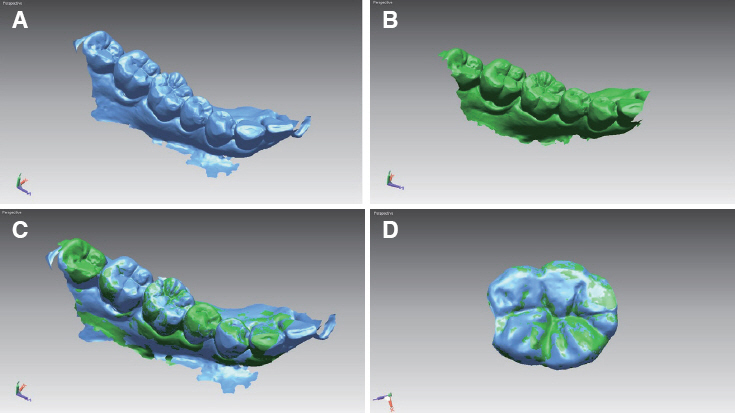J Dent Rehabil Appl Sci.
2017 Dec;33(4):252-259. 10.14368/jdras.2017.33.4.252.
Clinical study on the comparison of gold and zirconia wear in an implant-supported fixed prosthesis
- Affiliations
-
- 1Department of Prosthodontics, Oral Science Research Center, College of Dentistry, Yonsei University, Seoul, Republic of Korea.
- 2Department of Prosthodontics, College of Dentistry, Yonsei University, Seoul, Republic of Korea.
- 3Division in Prosthodontics, Department of Dentistry, School of Medicine, Inha University, Incheon, Republic of Korea. onsdo@inha.ac.kr
- KMID: 2405537
- DOI: http://doi.org/10.14368/jdras.2017.33.4.252
Abstract
- PURPOSE
The purpose of this study was to compare and analyze the wear of a prosthesis for 6 months after restoration with implant-supported fixed dental prosthesis made of either zirconia or gold.
MATERIALS AND METHODS
This study was conducted on patients requiring implant-supported fixed dental prostheses on first or second molar from January, 2015 to January, 2016. A total of 47 prostheses and antagonists were examined. Occlusal surface was recorded by impression of each prosthesis and antagonist 1 week and 6 months after prosthesis delivery. The digital files were created by impression scan. Occlusal shapes of 1 week and 6 months were compared and wear of prostheses and antagonists was analyzed. The Mann-Whitney test was used to analyzed the result data underwent normality test using SPSS (Version 23.0, IBM Corporation)
RESULTS
Mann-Whitney test revealed that there was no statistically significant difference in the median amount of mean vertical wear for 6 months in zirconia (50.84 μm) and gold (42.84 μm) prostheses (P > 0.05). When the opposing teeth were natural, the median amount of mean vertical wear of zirconia and gold prostheses was 47.72 μm and 41.97 μm, respectively, and the median amount of mean vertical wear of enamel was 47.26 μm and 44.59 μm, respectively. Statistical analysis showed no significant difference (P > 0.05).
CONCLUSION
Despite the short study period and the small number of experimental groups, zirconia and gold showed no significant difference in wear during the first 6 months. Opposing natural enamel also showed no significant difference in the wear.
Keyword
MeSH Terms
Figure
Reference
-
References
1. Piconi C, Maccauro G. Zirconia as a ceramic biomaterial. Biomaterials. 1999; 20:1–25. DOI: 10.1016/S0142-9612(98)00010-6.2. Guazzato M, Albakry M, Ringer SP, Swain MV. Strength, fracture toughness and microstructure of a selection of all-ceramic materials. Part II. Zirconiabased dental ceramics. Dent Mater. 2004; 20:44956. PMID: 15081551.3. Beuer F, Stimmelmayr M, Gueth JF, Edelhoff D, Naumann M. In vitro performance of full-contour zirconia single crowns. Dent Mater. 2012; 28:449–56. DOI: 10.1016/j.dental.2011.11.024. PMID: 22196898.4. Kim MJ, Oh SH, Kim JH, Ju SW, Seo DG, Jun SH, Ahn JS, Ryu JJ. Wear evaluation of the human enamel opposing different Y-TZP dental ceramics and other porcelains. J Dent. 2012; 40:979–88. DOI: 10.1016/j.jdent.2012.08.004. PMID: 22892464.5. Mitov G, Heintze SD, Walz S, Woll K, Muecklich F, Pospiech P. Wear behavior of dental Y-TZP ceramic against natural enamel after different finishing procedures. Dent Mater. 2012; 28:909–18. DOI: 10.1016/j.dental.2012.04.010. PMID: 22608163.6. Heintze SD, Cavalleri A, Forjanic M, Zellweger G, Rousson V. Wear of ceramic and antagonist-a systematic evaluation of influencing factors in vitro. Dent Mater. 2008; 24:433–49. DOI: 10.1016/j.dental.2007.06.016. PMID: 17720238.7. Mahalick JA, Knap FJ, Weiter EJ. Occlusal wear in prosthodontics. J Am Dent Assoc. 1971; 82:154–9. DOI: 10.14219/jada.archive.1971.0018. PMID: 4921710.8. Sulong MZ, Aziz RA. Wear of materials used in dentistry: a review of the literature. J Prosthet Dent. 1990; 63:342–9. DOI: 10.1016/0022-3913(90)90209-U.9. Hacker CH, Wagner WC, Razzoog ME. An in vitro investigation of the wear of enamel on porcelain and gold in saliva. J Prosthet Dent. 1996; 75:14–7. DOI: 10.1016/S0022-3913(96)90412-6.10. al-Hiyasat AS, Saunders WP, Sharkey SW, Smith GM, Gilmour WH. Investigation of human enamel wear against four dental ceramics and gold. J Dent. 1998; 26:487–95. DOI: 10.1016/S0300-5712(97)00041-9.11. Janyavula S, Lawson N, Cakir D, Beck P, Ramp LC, Burgess JO. The wear of polished and glazed zirconia against enamel. J Prosthet Dent. 2013; 109:22–9. DOI: 10.1016/S0022-3913(13)60005-0.12. Mundhe K, Jain V, Pruthi G, Shah N. Clinical study to evaluate the wear of natural enamel antagonist to zirconia and metal ceramic crowns. J Prosthet Dent. 2015; 114:358–63. DOI: 10.1016/j.prosdent.2015.03.001. PMID: 25985742.13. Kwon MS, Oh SY, Cho SA. Two-body wear comparison of zirconia crown, gold crown, and enamel against zirconia. J Mech Behav Biomed Mater. 2015; 47:21–8. DOI: 10.1016/j.jmbbm.2014.11.029. PMID: 25837341.
- Full Text Links
- Actions
-
Cited
- CITED
-
- Close
- Share
- Similar articles
-
- Maxillary cement retained implant supported monolithic zirconia prosthesis in a full mouth rehabilitation: a clinical report
- Implant supported fixed prosthesis for complete edentulous maxilla with severe alveolar ridge resorption: A case report
- Implant-Supported Fixed Dental Prostheses with New Retention Type Using Zirconia Ball and Nickel-Titanium Spring
- Full mouth rehabilitation of edentulous patient with fixed implant prosthesis
- Considerations for the Survival of Complete Arch Implant-Supported Zirconia Restorations; Status of Antagonistic Arches and Stress Distribution on Frameworks: A Case Report



